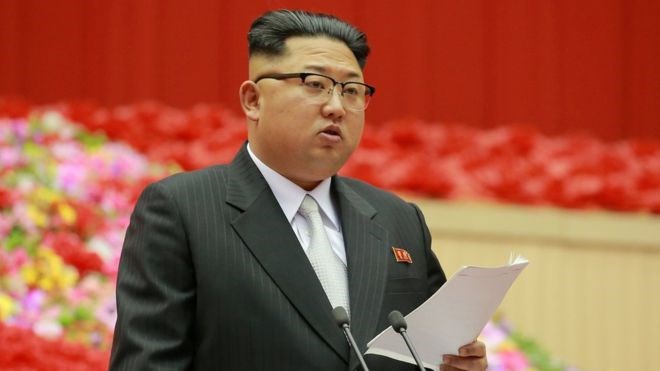North Korea ‘close to testing long-range missiles’

North Korean leader Kim Jong-un has said the country is close to testing long-range missiles capable of carrying nuclear warheads.
The intercontinental ballistic missiles were in their “last stage” of development, Mr Kim claimed during his New Year’s message.
Pyongyang has conducted two nuclear tests in the past year, including its biggest one to date.
This raised fears that North Korea has made significant nuclear advances.
But it has never successfully test-fired such a missile.
Reuters reported a senior US military official as saying that although North Korea appears able to put a miniaturised nuclear warhead on a missile, the missile re-entry technology necessary for longer range strikes is still a serious obstacle to its weapons development.
How advanced is North Korea’s nuclear programme?
Mr Kim, who took control of the secretive state following his father’s death in 2011, said in a televised speech: “Research and development of cutting edge arms equipment is actively progressing and ICBM (inter-continental ballistic missile) rocket test launch preparation is in its last stage.”
He said the country was now a “military power of the East that cannot be touched by even the strongest enemy”.
UN resolutions call for an end to the country’s nuclear and missile tests.
Two audiences: Steve Evans, South Korea correspondent:
Kim Jong-un was speaking to two audiences: one inside the country and one outside, particularly in the United States.
On both counts, it is in his interests to talk up the country’s strength.
He did not say that he had achieved his ambition of having a warhead small enough to go on reliable and accurate intercontinental missiles – but he said success was near.
Outside experts reckon it might take less than five years. The North Korean diplomat who defected from the London embassy thinks it will happen by the end of 2017.
It’s not clear what US President-elect Donald Trump might do about it. Military experts say the North Korean nuclear programme is too advanced and well-protected to destroy by force. The key facilities are hidden and dispersed.
When North Korea tested its nuclear bomb in September 2016, estimates varied on how strong it was.
South Korea’s military said its yield was about 10 kilotonnes, enough to make it the North’s “strongest nuclear test ever”. Other experts say initial indications suggest 20 kilotonnes or more.
The bomb dropped by the US on Hiroshima in 1945 had a yield of about 15 kilotonnes.
The September test triggered widespread condemnation and further international sanctions against the country.